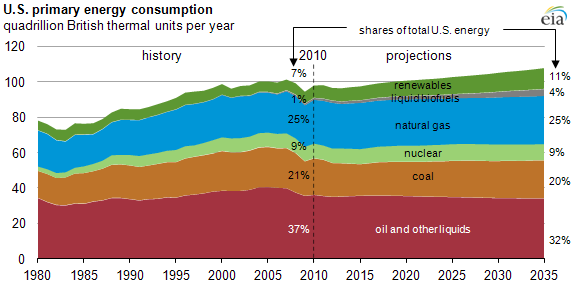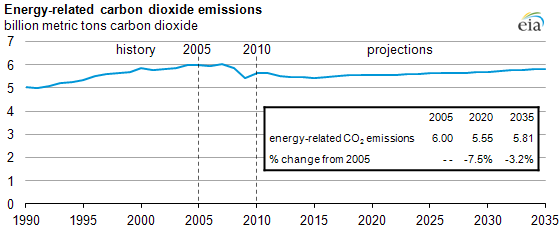
U.S. energy use projected to grow slowly and become less carbon-intensive

Note: The renewables category excludes liquid biofuels.
Download CSV Data
Both energy consumption and energy-related carbon dioxide emissions fell during the recent economic recession. Projections contained in the Early Release Reference case of the Annual Energy Outlook 2012 (AEO2012) show the United States' primary energy consumption only exceeding its pre-recession peak early in the next decade. However, due to the shift towards less carbon-intensive fuels, the carbon dioxide (CO2) emissions associated with U.S. energy consumption are not projected to exceed their 2007 peak by the end of the projection in 2035.
The largest projected growth in primary energy consumption between 2010 and 2035 is in renewables (4.8 quadrillion British thermal units (Btu), excluding liquid biofuels), liquid biofuels (2.9 quadrillion Btu), and natural gas (2.5 quadrillion Btu). The 2035 shares of other energy sources, including nuclear, coal, oil, and other liquids, either decline or remain similar to their 2010 shares. This projected shift in fuel consumption leads to lower energy intensity.
Energy-related CO2 emissions are projected to grow by about 3% from 2010 from 2035, reaching 5.8 billion metric tons by the end of the projection period (see chart below). The electric and transportation sectors emit the largest amounts of CO2. In 2007, energy-related emissions were responsible for 6.0 billion metric tons of carbon dioxide. Growth in CO2 emissions in the transportation sector is moderated by projected higher energy prices, Federal corporate average fuel economy (CAFE) standards, and the use of biofuels. Electric sector CO2 emissions growth is tempered by efficiency standards and changes in the generation mix as renewable fuels and natural gas fuel a growing share of power generation.
Projections in the AEO2012 Early Release Reference case assume current laws and regulations remain generally unchanged throughout the projection period, thus serving as a starting point for analysis of energy policies. More highlights from the Reference case, as well as projections for several energy factors through 2035, are available in the AEO2012.

Download CSV Data